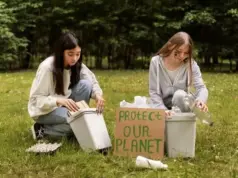The circular economy idea has drawn a lot of attention in the race to create a more sustainable future. The circular economy seeks to reduce waste, increase resource efficiency, and advance long-term sustainability in contrast to the conventional linear economy, which uses a “take-make-dispose” approach. This article describes the circular economy and emphasises its significance for accomplishing sustainability objectives.
Definition of the Circular Economy
The circular economy is a type of economics that aims to separate economic growth from resource consumption and environmental damage. It is founded on three key tenets: preventing waste and pollution through design, preserving materials and goods, and renewing natural systems. The goal is to establish a closed-loop system where resources are effectively used and continuously circulated.
Important Ideas and Techniques:
Various tactics and tenets are used to implement the circular economy. These consist of:
- Reducing waste and pollution: Stressing the value of waste prevention, long-lasting product design, and the use of renewable resources.
- Extending product lifespan: Promoting product repair, reuse, and refurbishing to prolong the life of products instead of prematurely discarding them.
- Embracing recycling and upcycling: Supporting material recycling so that trash can be turned into new resources and upcycling so that waste can be turned into higher-value products.
- Adoptive regenerative practises: Adopting regenerative practises, such as regenerative agriculture, focuses on repairing ecosystems in order to protect and improve natural resources.
Circular Economy Advantages
There are many advantages of sustainability provided by the circular economy:
- Resource conservation: The circular economy minimises the extraction of raw materials, conserving natural resources and lessening environmental impacts. This is done by minimising waste and maximising resource efficiency.
- Economic expansion and job creation: Moving towards a circular economy can promote economic expansion by fostering the development of new industries, the creation of jobs, and the advancement of resource-efficient technology.
- Lower greenhouse gas emissions and the fight against climate change: The circular economy lessens the need for energy-intensive extraction and production methods.
- Strengthened economic security and resilience: The circular economy promotes local production, lessens reliance on scarce resources, and diversifies supply networks to increase resilience and security.
- Reduced landfill and pollution: The circular economy reduces the quantity of waste transported to landfills and the pollution associated with waste disposal by placing a strong emphasis on waste prevention, recycling, and upcycling.
- Cost savings: Both organisations and people can save a lot of money by adopting circular practices. Costs associated with production, waste management, and resource acquisition can be decreased by extending product lifespans, reusing materials, and adopting resource-efficient procedures.
- Jobs and innovation: The circular economy promotes the creation of new technologies, business models, and services, which fosters innovation. This encourages the establishment of sustainable industries, boosts job creation, and opens up chances for entrepreneurs.
- Sustainable consumption patterns: The circular economy promotes the idea of sharing, leasing, and product-as-a-service models in order to counter the current culture of overconsumption. Encouraging people to use products instead of owning them, lowers the demand for production that requires a lot of resources.
Conclusion
In conclusion, the circular economy presents a workable route to sustainable development. We can reduce waste, save resources, and promote economic and environmental resilience by reimagining how we generate, consume, and manage resources. Addressing the problems of resource scarcity, climate change, and environmental degradation requires embracing the circular economy’s principles. We can create a more environmentally friendly and prosperous future for all as people, corporations, and governments collaborate to apply circular practices.










































